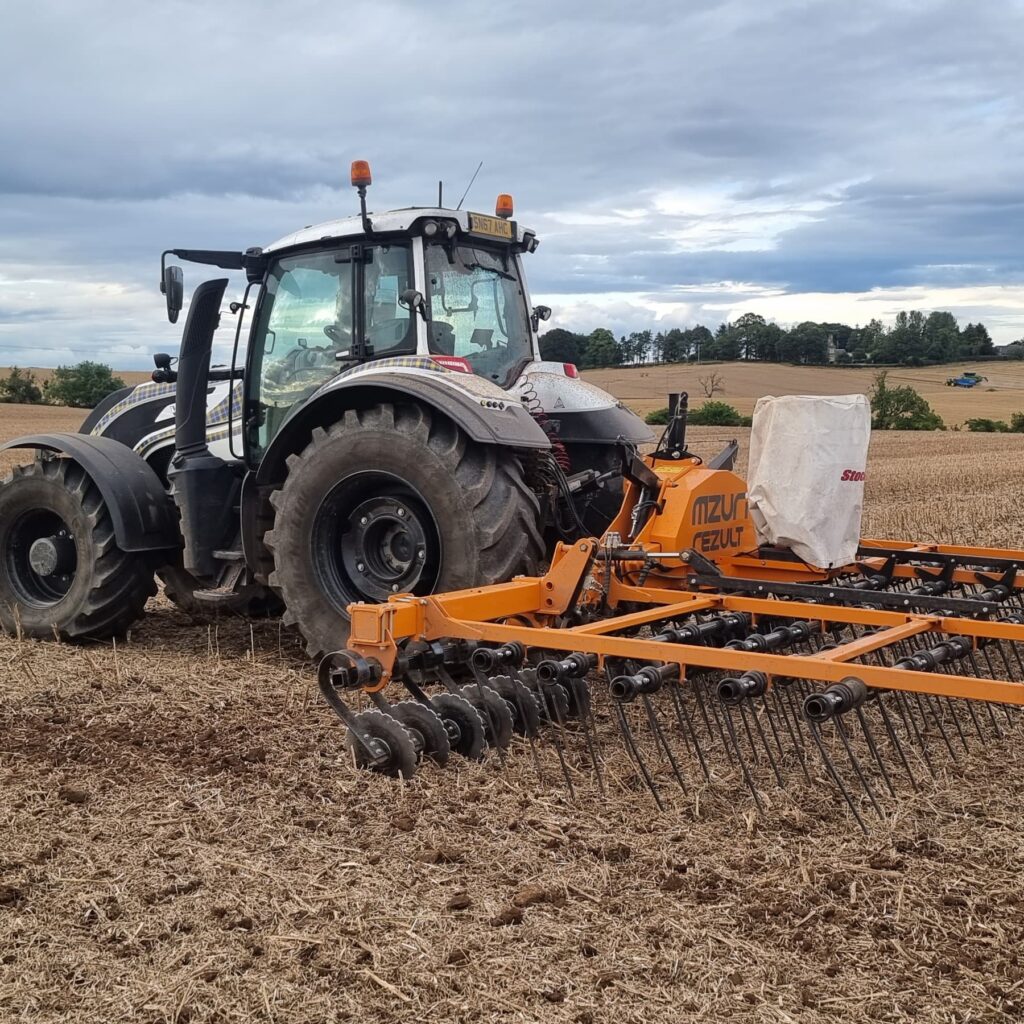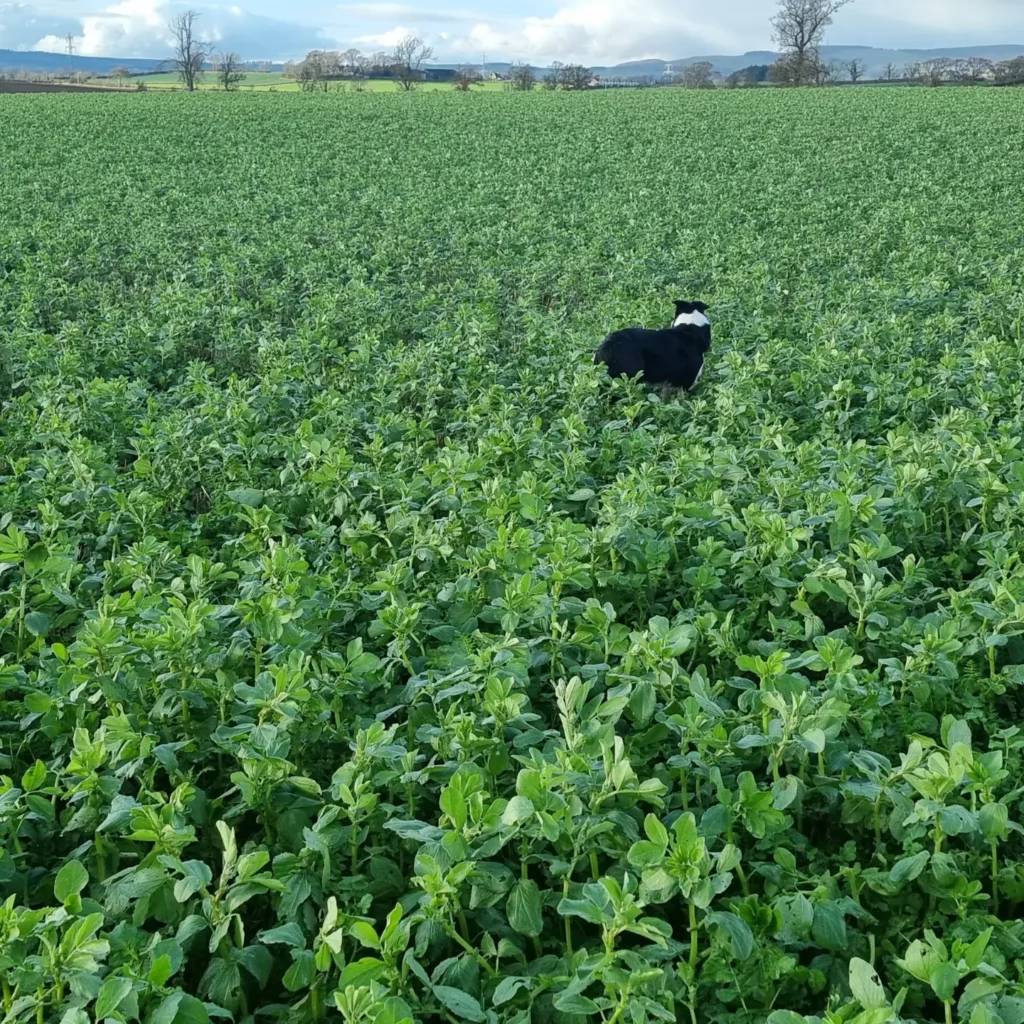Written September 2023
As I write this the sun shines, almost ironically as the cereals are all cut and only the beans remain to be harvested. It has been a very stop start affair from the very start, but not impossible, and easier and more rewarding than many around the UK have experienced.
This is the first harvest where all my crops were sown after only a pass with the straw rake, stubbles sprayed, then drilled with the Mzuri. In the past I have ploughed around 60% of the ground planned for winter and spring barley after wheat. This season I left the plough in the shed and direct drilled my winter and spring barley which all went into Simpsons Malt. I decided to cover all stubbles with the rake last autumn and it helped get a chit in what was a very dry autumn. I still believe that each pass with the rake halves the slug numbers which reduces my pellet use. Usually, 1 application of slug pellets with the drill for osr and wheat following osr. I don’t know if any research has been done to prove the reduction with the rake, but it is something I have found over the years. All crops looked well all winter but once again the winter barley seemed to drop a tiller in the wet cool spring here. This led to a thinner crop and an average yield at best, but that did seem to be common across all establishment types in the area. This year I will go at least a week to 10 days earlier sowing my winter barley, Sep. 5th , and again use variable seed rate as it is making the crops noticeably more even. There has been some very flat wheat this year and I had some myself. Rolling direct drilled ground does require some stone picking, my ground isn’t very stoney, but I did end up picking a lot of stones from the centre belt stone trap on my convio header this year, reminding me to be more vigilant in future. The flat wheat was sown at variable rate and the light ground receiving the lowest rate but still went down first. I think that tiller numbers in the Dawsum, even at the lower rate were still so high that on a relatively low 188kg of N it still managed to go very flat very early. The head count in some areas was almost 1000/sqm from 150kg/Ha or 330ssqm. The question now is do I go to 140kg/Ha for my low rate when I sow this week? Seems low.
The Diablo spring malting barley was all direct drilled. Most was drilled into overwintered stubble, but some went in after a poor crop of stubble turnips and some after the spring bean, phacelia, radish and buckwheat winter cove. The cover worked well, I was concerned that it would hold too much moisture in the topsoil for spring sowing, so beans and buckwheat were included as they die off with frost, leaving the radish and phacelia. A friends sheep grazed the remaining cover which paid for the seed. This did offer a great reminder to my family of our livestock days; we were out on boxing day chasing sheep around next doors osr. After that, what remained was sprayed off and it finally dried enough to sow on the 8th April pushed on by a poor forecast (a reason used a lot this year). The seedbed was mostly in good order, but some heavier areas were definitely compromised, remaining wet and sticky, and looked like they would struggle to establish. Wet weather followed then extreme dry. 5 weeks with no rain, mid-May to mid-June. The crop however, after some spot slug pelleting, came away not too badly, then survived the dry spell amazingly well and better than the ploughed combi drilled barley in the area. Dry topsoil with moisture retained at depth is a massive benefit with my system and that was obvious this spring. I did however think the field would out yield my other barleys as it had always looked stronger and thicker. The final yield was very similar to the other Diablo but the straw crop was easily double the size. This turned out to be a disadvantage as 45mm of rain after cutting meant I had to turn the straw twice before baling. I will try winter cover to spring barley again this year and see if the results differ. I have sown a similar mix again this year, beans down the front leg, phacelia and radish out the coulter. This was sown on Aug. 15th into wheat stubble and will be sprayed off before drilling Diablo spring barley for Simpsons malt. I have some cover crop seed coming from Simpsons for a trial 5 Ha plot to gather some info on effects of winter cover crops on soils and the following spring barley.

Due to a low price, I chopped more than half of my straw this year, that is more than ever, and it has saved a lot of running back over the ground, so helping to keep it level and hopefully putting some OM back. Last years wheat straw was completely gone come spring which is a sign of a worm activity and a healthy soil.
The harvest was a good one with WB just below average, OSR on the 3-year average, wheat above average, variable with some very big yields, spring barley below last year’s high but unfortunately nitrogen’s are high so some deductions may follow and finally the spring beans which are well podded but a good 2 feet shorter than usual. Beans are sprayed off but a good 10 days until cutting as I write. Everything has required drying, not unusual for here but costly all the same. Some OSR was cut at similar moisture to the wheat (which also needed dried, that’s a clue) but it is in the shed!
This years OSR is rowed up and has received its first spray, no insecticide added as the damage was below threshold numbers. I don’t sow osr at variable rate, so I was able to use the map to vary the slug pellets rate instead. I started at full rate on the heavier soil and then worked back from there. I ended up using less than the flat rate and it seems to be sufficient, IPM in action. Around 80% had chicken muck spread on the stubble prior to sowing and the dry conditions meant very little compaction. I am always very conscious that spreading muck in anything but perfect conditions isn’t really a good thing. I am direct drilling my winter barley into wheat stubbles again but this year I have managed to get a reasonable chit of volunteer’s and some grass weeds. It was a bad year for brome in this area and I know I will have to plan my spray program to avoid allowing it to become a bigger problem. Raking, chitting and planning spray programs on known areas are now a priority.

I was nominated and entered the FW arable farmer of the year awards and made the final 3 with the winner announced on October the 5th at the dinner. The judges visit in July was very interesting and made me look again at what I do and the many benefits the system has over my old one. One thing that concerned me was I don’t really have a lot of machinery to look at. I pointed this out because I obviously see it as a positive and the judges noted that in the past machinery was the first thing they looked at, now the soil and the system were the key things. The whole discussion felt like real recognition, that what the farmers in this magazine practice is slowly becoming, as the magazine joked in its title change, ‘Normal Farming’. The judges did also agree it was strange that if I farmed 6 miles south of here (England) I would have qualified over the years, for around 60K of funding for my drill, rake and newly laid concrete. Being in Scotland I can’t access any scheme. Arable farming is mostly ignored unless its red tape, EFA or greening. Being honest I don’t really want government interference, but that’s a lot of money!

The Profitability and Sustainability group, which I am part of, has received another raft of funding (for facilitators not participants) which is good, but it makes me realise that there is money out there and we as farmers must have access to it. It is already being used in our name, so we best get out there!




